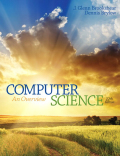
EBK COMPUTER SCIENCE: AN OVERVIEW
12th Edition
ISBN: 8220102744196
Author: BRYLOW
Publisher: PEARSON
expand_more
expand_more
format_list_bulleted
Concept explainers
Question
Chapter 10, Problem 30CRP
Program Plan Intro
z-buffer:
z-buffer is a technique in
Expert Solution & Answer
Want to see the full answer?
Check out a sample textbook solution
Students have asked these similar questions
using r language to answer question 4. Question 4: Obtain a 95% standard normal bootstrap confidence interval, a 95% basic bootstrap confidence interval, and a percentile confidence interval for the ρb12 in Question 3.
using r language
using r language
Chapter 10 Solutions
EBK COMPUTER SCIENCE: AN OVERVIEW
Ch. 10.1 - Prob. 1QECh. 10.1 - Prob. 2QECh. 10.1 - Prob. 3QECh. 10.2 - Prob. 1QECh. 10.2 - Prob. 2QECh. 10.2 - Prob. 3QECh. 10.3 - Prob. 1QECh. 10.3 - Prob. 2QECh. 10.3 - Prob. 3QECh. 10.3 - Prob. 4QE
Ch. 10.3 - Prob. 5QECh. 10.4 - Prob. 1QECh. 10.4 - Prob. 2QECh. 10.4 - Prob. 3QECh. 10.4 - Prob. 4QECh. 10.4 - Prob. 5QECh. 10.5 - Prob. 1QECh. 10.5 - Prob. 2QECh. 10.5 - Prob. 3QECh. 10.5 - Prob. 4QECh. 10.6 - Prob. 1QECh. 10.6 - What is a storyboard?Ch. 10.6 - Prob. 3QECh. 10.6 - Prob. 4QECh. 10 - Prob. 1CRPCh. 10 - Prob. 2CRPCh. 10 - Prob. 3CRPCh. 10 - Prob. 4CRPCh. 10 - Prob. 5CRPCh. 10 - Prob. 6CRPCh. 10 - Prob. 7CRPCh. 10 - Prob. 8CRPCh. 10 - Prob. 9CRPCh. 10 - Prob. 10CRPCh. 10 - Prob. 11CRPCh. 10 - Prob. 12CRPCh. 10 - Prob. 13CRPCh. 10 - Prob. 14CRPCh. 10 - Prob. 15CRPCh. 10 - Prob. 16CRPCh. 10 - Prob. 17CRPCh. 10 - Prob. 18CRPCh. 10 - Prob. 19CRPCh. 10 - Prob. 20CRPCh. 10 - Prob. 21CRPCh. 10 - Prob. 22CRPCh. 10 - Prob. 23CRPCh. 10 - Prob. 24CRPCh. 10 - Prob. 25CRPCh. 10 - Prob. 26CRPCh. 10 - Prob. 27CRPCh. 10 - Prob. 28CRPCh. 10 - Prob. 29CRPCh. 10 - Prob. 30CRPCh. 10 - Prob. 31CRPCh. 10 - Prob. 32CRPCh. 10 - Prob. 33CRPCh. 10 - In what way does the hardware in a computer...Ch. 10 - Prob. 35CRPCh. 10 - Prob. 36CRPCh. 10 - Prob. 37CRPCh. 10 - Prob. 38CRPCh. 10 - Prob. 39CRPCh. 10 - Prob. 40CRPCh. 10 - Prob. 41CRPCh. 10 - Prob. 42CRPCh. 10 - Prob. 43CRPCh. 10 - Prob. 44CRPCh. 10 - Prob. 1SICh. 10 - The following questions are intended as a guide to...Ch. 10 - Prob. 3SICh. 10 - Prob. 4SI
Knowledge Booster
Learn more about
Need a deep-dive on the concept behind this application? Look no further. Learn more about this topic, computer-science and related others by exploring similar questions and additional content below.Similar questions
- using r language Obtain a bootstrap t confidence interval estimate for the correlation statistic in Example 8.2 (law data in bootstrap).arrow_forwardusing r language Compute a jackknife estimate of the bias and the standard error of the correlation statistic in Example 8.2.arrow_forwardusing r languagearrow_forward
- using r languagearrow_forwardThe assignment here is to write an app using a database named CIT321 with a collection named students; we will provide a CSV file of the data. You need to use Vue.js to display 2 pages. You should know that this assignment is similar, all too similar in fact, to the cars4sale2 example in the lecture notes for Vue.js 2. You should study that program first. If you figure out cars4sale2, then program 6 will be extremely straightforward. It is not my intent do drop a ton of new material here in the last few days of class. The database contains 51 documents. The first rows of the CSV file look like this: sid last_name 1 Astaire first_name Humphrey CIT major hrs_attempted gpa_points 10 34 2 Bacall Katharine EET 40 128 3 Bergman Bette EET 42 97 4 Bogart Cary CIT 11 33 5 Brando James WEB 59 183 6 Cagney Marlon CIT 13 40 GPA is calculated as gpa_points divided by hrs_attempted. GPA points would have been arrived at by adding 4 points for each credit hour of A, 3 points for each credit hour of…arrow_forwardI need help to solve the following case, thank youarrow_forward
- You will write a program that allows the user to keep track of college locations and details about each location. To begin you will create a College python class that keeps track of the csollege's unique id number, name, address, phone number, maximum students, and average tuition cost. Once you have built the College class, you will write a program that stores College objects in a dictionary while using the College's unique id number as the key. The program should display a menu in this order that lets the user: 1) Add a new College 2) Look up a College 4) Delete an existing College 5) Change an existing College's name, address, phone number, maximum guests, and average tuition cost. 6) Exit the programarrow_forwardShow all the workarrow_forwardConstruct a frequency polygon density estimate for the sample in Question 1, using bin width determined by Sturges’ Rule.arrow_forward
arrow_back_ios
SEE MORE QUESTIONS
arrow_forward_ios
Recommended textbooks for you
 Systems ArchitectureComputer ScienceISBN:9781305080195Author:Stephen D. BurdPublisher:Cengage Learning
Systems ArchitectureComputer ScienceISBN:9781305080195Author:Stephen D. BurdPublisher:Cengage Learning Principles of Information Systems (MindTap Course...Computer ScienceISBN:9781285867168Author:Ralph Stair, George ReynoldsPublisher:Cengage Learning
Principles of Information Systems (MindTap Course...Computer ScienceISBN:9781285867168Author:Ralph Stair, George ReynoldsPublisher:Cengage Learning New Perspectives on HTML5, CSS3, and JavaScriptComputer ScienceISBN:9781305503922Author:Patrick M. CareyPublisher:Cengage Learning
New Perspectives on HTML5, CSS3, and JavaScriptComputer ScienceISBN:9781305503922Author:Patrick M. CareyPublisher:Cengage Learning Fundamentals of Information SystemsComputer ScienceISBN:9781305082168Author:Ralph Stair, George ReynoldsPublisher:Cengage LearningCOMPREHENSIVE MICROSOFT OFFICE 365 EXCEComputer ScienceISBN:9780357392676Author:FREUND, StevenPublisher:CENGAGE L
Fundamentals of Information SystemsComputer ScienceISBN:9781305082168Author:Ralph Stair, George ReynoldsPublisher:Cengage LearningCOMPREHENSIVE MICROSOFT OFFICE 365 EXCEComputer ScienceISBN:9780357392676Author:FREUND, StevenPublisher:CENGAGE L

Systems Architecture
Computer Science
ISBN:9781305080195
Author:Stephen D. Burd
Publisher:Cengage Learning


Principles of Information Systems (MindTap Course...
Computer Science
ISBN:9781285867168
Author:Ralph Stair, George Reynolds
Publisher:Cengage Learning

New Perspectives on HTML5, CSS3, and JavaScript
Computer Science
ISBN:9781305503922
Author:Patrick M. Carey
Publisher:Cengage Learning

Fundamentals of Information Systems
Computer Science
ISBN:9781305082168
Author:Ralph Stair, George Reynolds
Publisher:Cengage Learning

COMPREHENSIVE MICROSOFT OFFICE 365 EXCE
Computer Science
ISBN:9780357392676
Author:FREUND, Steven
Publisher:CENGAGE L